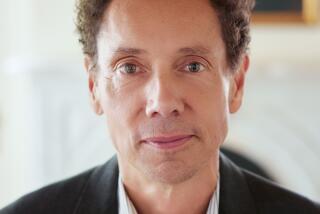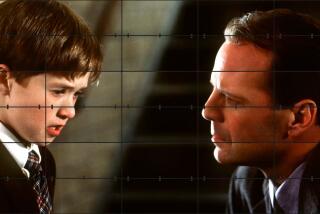First impressions, lasting effects
The idea is simple, so simple it doesn’t even seem like an idea. More like an intuition. Or a flash even, a first impression, if you will. A first impression, yes, for this is the heart of the matter: that first impressions are powerful things. They reverberate, argues Malcolm Gladwell in his new book “Blink: The Power of Thinking Without Thinking,” affecting how we interact with the world around us, and even with ourselves.
Take the case of the ancient Greek kouros -- a statue of a naked boy -- that the J. Paul Getty Museum bought for nearly $10 million in 1983. Although experts authenticated the kouros, the statue left other art historians cold. To one, it had to do with the fingernails; they didn’t look right. To another, it was a hunch, “an instinctive sense that something was amiss.” Eventually, Gladwell writes, doubts about the kouros snowballed and it was proved to be a fraud.
How did this happen? How did the dissenters know? It seems the simplest of questions and, at the same time, unimaginably complex. “I like to find hidden complications in prosaic subjects,” Gladwell says on a recent afternoon in San Francisco. “And this was such an obvious idea -- that we make snap judgments and they have an impact on the world. It’s the most basic, non-arguable idea. But snap judgments are wonderful because they’re messy. It’s just a wonderfully complex world to explore.”
For Gladwell, this is the stuff of an aha moment, a seemingly mundane interaction that opens up the world. At 41, he has carved out a writerly territory defined by such impulses, a landscape that involves elements of psychology and marketing but supercedes them both. A staff writer at the New Yorker, for whom he covers subjects as diverse as SUVs and disposable diapers, he is best known as the author of “The Tipping Point,” a study of trends and social behavior that became a surprise bestseller in 2000.
Although he speaks frequently to business symposiums as an expert on group dynamics, to sit with him is to get a different impression: of a man who is thoughtful but also cautious and slightly ill at ease. In conversation, Gladwell often starts a sentence and then rephrases it, as if he were editing himself in real time. He illustrates his points by gesturing with his fingers, which are long and tapered, and his face is framed by an explosion of curly brown hair. It was his hair, in fact, which he grew out a few years ago, that led to “Blink,” after three New York City police officers stopped him on the street.
“They were looking,” he writes, “for a rapist, and the rapist, they said, looked a lot like me.” When Gladwell read the description, however, he realized that he and the rapist had nothing in common -- except their hair. “I was already interested in this notion of first impressions,” he recalls, “but I didn’t know what to do with it. This made it all personally relevant. This thing I’d read about for years, racial profiling, it finally clicked: It’s real. I’d never really encountered racism before because although I’m biracial, it’s not obvious. My skin is light. But all of a sudden, in my late 30s, I was inspiring a reaction from people based on this totally trivial aspect of my appearance. It didn’t make me angry; it just made me intensely curious.”
“Blink” is an attempt to find a context for these instant judgments, to look inside the instinctual. It focuses on the first two seconds we spend in any situation, a flash that often illuminates everything. If the book has a message, actually, it is that we should train ourselves to listen to our hunches, which are often uncannily accurate. This is the idea behind thin-slicing, “the ability of our unconscious to find patterns in situations and behavior based on very narrow slices of experience.” (The art experts who debunked the Getty’s kouros were thin-slicers with highly developed intuitions that “told” them something was off.)
According to Gladwell, the process is often inexplicably elusive; for financier George Soros, a bad investment can literally evoke back spasms, while tennis coach Vic Braden is able to “predict” when players will double fault just by watching how they move. “Something in the way the tennis players hold themselves,” Gladwell writes, “or the way they toss the ball, or the fluidity of their motion triggers something in his unconscious. He instinctively picks up the [sense] of a double fault. He thin-slices some part of the service motion and -- blink! -- he just knows. But here’s the catch: much to Braden’s frustration, he simply cannot figure out how he knows.”
Although such “blink moments” would seem to be intuitive, they are, Gladwell notes, the product of unconscious conditioning, which helps determine how we react. As an example, he points to orchestral auditions, which have been held behind screens for 30 years now -- ever since it was discovered that conductors routinely overlooked female musicians.
“To me,” Gladwell says, “this is the single most striking story in the book, the thing about the screens. The idea that even a maestro could have his ability to judge music, his life’s love, impaired by his unconscious feelings about women. That was so, in a way, tragic. It made me think: If this is going on with a maestro, in how many situations are my unconscious feelings affecting how I behave?” Of course, when it comes to the unconscious, it’s not just our attitudes toward others that are at issue, but also how we see ourselves.
Unconscious biases
Early in the book, Gladwell cites an experiment in which a group of black collegians were given questions from the Graduate Record Examination. First, they were tested without having to identify themselves in any fashion; then, in a retest, they were asked to list their race. “When the students were asked to identify their race on a pretest questionnaire,” he writes, “that simple act was sufficient to prime them with all the negative stereotypes associated with African Americans and academic achievement -- and the number of items they got right was cut in half.” It’s a stunning bit of research, and it pinpoints just how intensely the unconscious underscores our lives.
In many ways, what Gladwell’s getting at is the notion of free will, of autonomy, of how much we do (or do not) actively shape our relationship to the world. Among the book’s most disturbing conclusions is that we may not, in fact, be in control of anything -- that, as Gladwell puts it, “all we’re doing is making up stories.”
To illustrate the concept, he writes at length about taste tests, packaging, why we buy the things we do. Many of us, for example, believe ice cream tastes better in round containers than square ones, and are willing to pay more for it that way. It’s the illusion of quality rather than actual quality, but if this means that we’re open to manipulation, Gladwell contends it may be what we want. “Is satisfying our unconscious biases as legitimate as satisfying our conscious biases?” he asks.
“I think it is. If you think about the person you’re in love with, you’re not just in love because they satisfy your conscious needs. That’s how I would explain the round ice cream container, that thinking I’m eating high-quality ice cream is the same to me as eating high-quality ice cream. They’re not separable things.”
Psychology, it turns out, offers a variety of corollaries to this phenomenon, from “priming,” in which external cues trigger internal biases that affect our actions (the GRE experiment is an example) to the idea that facial expressions may be enough to set off “the physiological signals of such emotions as anger, sadness and fear” -- even if the actual emotion isn’t felt.
“There is,” Gladwell says, “a very persuasive branch of psychology which argues that much of what we think of as conscious is just an illusion. I didn’t want to go into that in my book because it’s really hard stuff, and I don’t feel I need to go that far. But you can’t read about the whole idea of priming and not call into question a huge chunk of what we think of as willed experience.”
Whether or not we’re truly conscious, there are, notes Gladwell, things that we can do. Such a notion motivates a radical protocol at Chicago’s Cook County Hospital, where doctors use a mathematical algorithm to determine whether emergency room patients are at risk of heart attack.
“You can’t be passive,” Gladwell says, “about the environments in which you make decisions. It’s the task of any society or institution to organize the decision-making playing field. You see that most clearly with doctors in the ER. If they can’t make good, instinctive decisions about who’s having a heart attack, you’ve got to step in, clear away the brushwood and show them how.”
Perhaps nowhere is this as important as in training police officers, for whom snap decisions often mean the difference between life and death. One of the most evocative sections of “Blink” deals with the 1999 killing of Amadou Diallo, a black man from Guinea who was shot 41 times by four plainclothes New York Police Department officers in a case of mistaken intent. Because the police officers in the Diallo case were inexperienced, they panicked, leaving them unable to read the situation for what it was.
“Why,” Gladwell asks, “couldn’t one of the four guys have been someone with 20 years experience? Put him in the back seat and maybe he would have looked at Diallo and said, ‘Wait a minute.’ Even one person, someone having the experience and the wisdom to raise one little question and suddenly everything dissolves.”
Listening to Gladwell talk about Diallo, you start to hear a whisper of his own experience. You also get a sense of how complex -- contradictory, even -- snap decisions can be. For the officers who mistook him for a rapist, their instant judgments were faulty, as they were for the officers in the Diallo case. “None of this,” Gladwell says, “is neat and tidy. The unconscious is not neat and tidy. All you can do is to introduce people to the contradictions and give them guidelines about the way to sort them out.”
As to how to do this, it all gets back to those first two seconds, as well as the willingness to take a deeper look. “I want people to understand very, very specific kinds of things,” Gladwell explains. “And let the larger lessons emerge out of that. I like the idea of zeroing in on something. If you can just take one little thing and zero in on it to the finest point, out of that, you can get a kind of world view.”
More to Read
The biggest entertainment stories
Get our big stories about Hollywood, film, television, music, arts, culture and more right in your inbox as soon as they publish.
You may occasionally receive promotional content from the Los Angeles Times.











